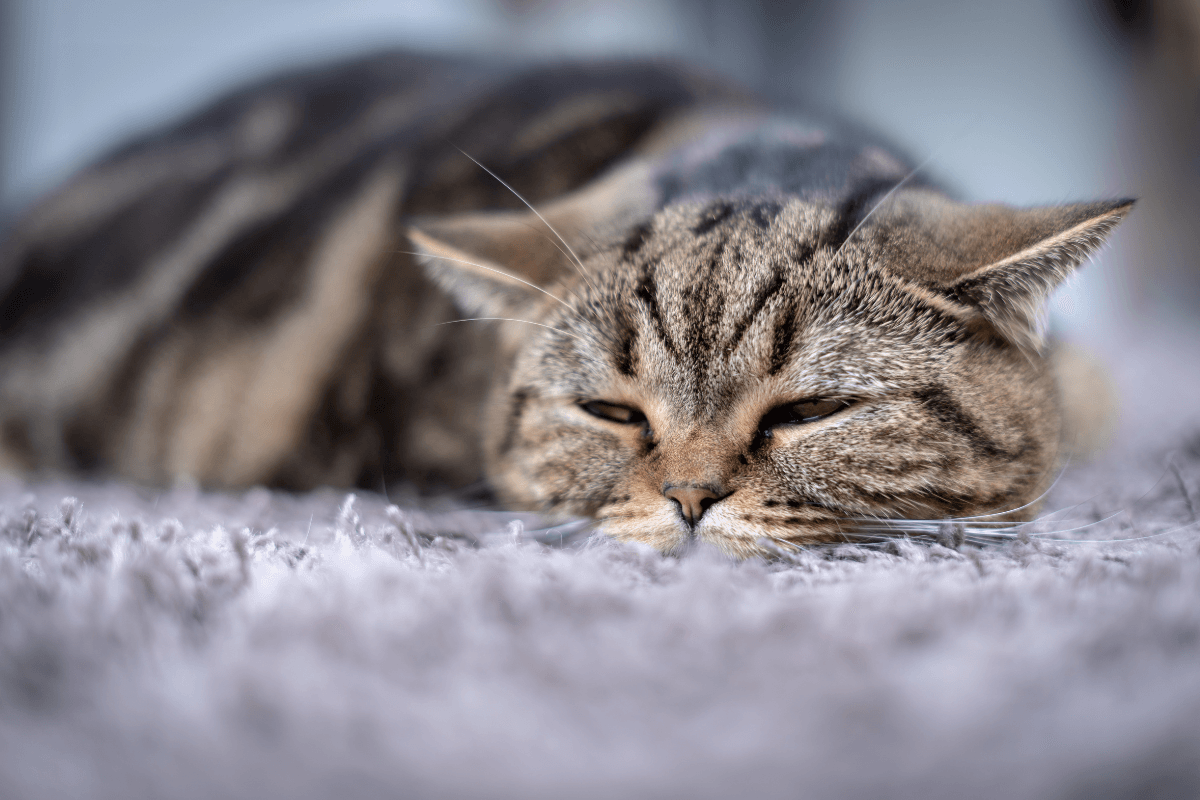Cats are notoriously subtle when it comes to showing pain. Unlike dogs, cats rarely cry out or limp openly; instead, pain in cats often manifests in subtle shifts in behavior or posture. Using tools like the Feline Grimace Scale, veterinarians can now more accurately detect acute pain through facial expressions.
If you ever wonder how to tell if your cat is in pain, knowing the warning signs and what to do next can make a huge difference in your feline’s comfort and health.
Why Cats Hide Pain
Cats have an instinctive ability to conceal discomfort. In the wild, showing weakness could make them easy targets for predators or cause them to lose social standing among other cats. This survival behavior has carried over to domestic life, which is why even a well-loved house cat often hides when injured or ill.
Instead of vocalizing or limping, cats often communicate pain through subtle behavioral changes, such as sleeping more, eating less, or avoiding interaction. Some may become unusually quiet, while others act defensively or withdraw. Because these clues are often easy to overlook, paying attention to small changes in your cat’s habits, posture, or facial expression is the key to early detection. Recognizing these quiet signals can help you catch a problem long before it becomes serious, ensuring faster treatment and better recovery.
Behavioral Clues: How Do I Know If My Cat Is Sick or in Pain?
- Reduced activity, hiding, or withdrawal: A cat that once loved exploring may now stay under furniture or in quiet corners.
- Loss of appetite or drinking less: Signs of pain in cats, especially in the mouth, abdomen, or joints, can make eating uncomfortable.
- Changes in grooming: Cats in pain often groom less, leaving their coat untidy, or they may over-groom a specific area, licking or biting to self-soothe.
- Altered litter box behavior: Straining, urinating outside the box, or avoiding it may indicate discomfort.
- Aggression or irritability: If a very gentle cat suddenly swats or bites when touched, it might be guarding a painful area.
These behavioral shifts often precede more visible symptoms.
Physical Postures & Positions: Cat Positions in Pain
Your cat’s posture can tell you a great deal about how it feels. When a cat is in pain, its body language often changes in subtle yet noticeable ways. Pain makes them move differently, sit more cautiously, or rest in protective positions that minimize discomfort.
Hunched back or tucked belly
A cat with abdominal pain may curl up tightly, arch its back, or tuck its belly under as if trying to shield itself. This posture helps protect sensitive organs. Cats with stomach discomfort, urinary issues, or internal inflammation often lie with their paws beneath their body and avoid being touched around the abdomen.
Reduced jumping or stiff movement
If your cat hesitates before jumping onto furniture, struggles with stairs, or lands awkwardly, it could be a sign of joint or muscle pain. Arthritis, injury, or muscle strain are common causes. Over time, you may notice your cat choosing lower resting spots or moving more slowly, especially after waking up from a nap.
Protecting or not using a limb
When a cat limps, holds a paw up, or avoids putting weight on one leg, it may be guarding a painful joint, tendon, or wound. In some cases, cats may lick or bite the sore area repeatedly, trying to self-soothe. A veterinarian should always check persistent limping or one-sided favoring.
Guarding posture
Cats experiencing pain often lower their body to the ground, crouch with tense muscles, or flatten their ears slightly. They may turn away or shrink back when touched in certain spots. This guarded stance is the body’s instinctive way of protecting itself from further discomfort.
Subtle changes in posture can be easy to miss at first, which is why it helps to observe your cat’s movements over several days. Comparing how your cat sits, walks, and stretches from one day to the next can reveal patterns that point to ongoing pain or stiffness.
Facial Signs My Cat is Sick: The Cat Grimace Scale
One of the most powerful tools is the Feline Grimace Scale (FGS), a method for assessing pain in your cat’s face using five action units.
These five features are:
- Ear position (flattened or rotated outward)
- Orbital tightening (squinted or narrowed eyes)
- Muzzle tension (tense, drawn mouth area)
- Whisker changes (whiskers straight or pushed forward instead of relaxed)
- Head position (head lowered or tucked)
Each unit is scored 0, 1, or 2. A total score of 4 or more (out of 10) suggests the cat is likely in pain and may need analgesia.
Because cats rarely vocalize, facial scoring provides a subtle yet reliable method for detecting acute discomfort.
Rare or Less Obvious Indicators
Some signs are less obvious but merit attention:
- Dilated pupils, glazed stare, or fixed gaze
- Panting at rest (uncommon in cats)—may suggest severe stress or pain
- Rapid breathing or shallow breaths
- Sudden changes in behavior after handling or movement
These signs may overlap with other illnesses, so veterinary evaluation is essential.
When Pain Becomes Chronic
Chronic pain develops slowly and can be mistaken for aging or laziness, yet it profoundly affects a cat’s quality of life.
- Gradual loss of mobility – The cat may struggle with activities such as climbing stairs, grooming, or jumping over time.
- Behavioral decline – Persistent irritability, restlessness, or hiding can indicate ongoing pain.
- Poor grooming or coat condition – Cats with arthritis or spinal pain may avoid twisting to reach certain areas.
- Loss of appetite and weight changes – Long-term discomfort often leads to reduced eating, resulting in gradual weight loss.
- Subtle personality shifts – Once-affectionate cats may avoid cuddling or being held due to tenderness or stiffness.
- Importance of regular vet visits – Chronic pain is manageable, but only if identified early through routine checkups and pain assessments.
What to Do If You Suspect Pain: Steps to Take
- Don’t administer human medicine — many drugs (e.g., acetaminophen) are toxic to cats.
- Make careful observations: Take photos or videos in calm settings to capture posture or facial cues.
- Visit your vet with details: Note when the changes began, what worsens or alleviates them, and any recent injuries.
- Diagnostic testing, including X-rays, blood tests, ultrasounds, and joint imaging, may help uncover underlying causes.
- Veterinary pain medications for cats: Your vet may prescribe analgesics safe for felines like NSAIDs formulated for cats, opioids, or adjunctive therapies, which can be purchased online.
- Supportive care: Provide soft bedding, easy access to litter boxes, food, and water at comfortable heights, and reduced need for jumping or climbing.
Medications and Pain Relief for Cats
When pain is confirmed, your veterinarian may prescribe safe pain medicine for cats that specifically targets the cause and intensity of discomfort. Standard options include nonsteroidal anti-inflammatory drugs (NSAIDs) formulated for feline use, such as meloxicam or robenacoxib, which help reduce inflammation and improve mobility.
In cases of severe or chronic pain, vets may also recommend opioid-based medications, nerve pain relievers, or corticosteroids, depending on the diagnosis. It’s important to remember that cats metabolize drugs differently from humans, and even a single tablet of acetaminophen or ibuprofen can be fatal. Never give over-the-counter medications without veterinary guidance. Regular monitoring, dose adjustments, and blood work ensure that pain management remains effective and safe for your cat over time.
For pet owners, managing a cat’s long-term comfort, cost, and accessibility matter just as much as compassionate care. You can find affordable, high-quality pain relief options for cats, prescribed and recommended by trusted veterinarians. Visit our Pet Medications Page to learn more about safe, vet-approved treatments and order conveniently to keep your feline companion comfortable and healthy.
Conclusion
Knowing how to tell if your cat is in pain isn’t always straightforward. The signs are often subtle shifts in behavior, posture, grooming, or even facial expression that can be the cat’s way of signaling discomfort. The Grimace Scale provides caretakers and veterinarians with a validated tool to assess acute pain using facial cues.
If you notice even mild red flags, document them and see your veterinarian promptly. Early detection leads to better outcomes, less suffering, and a healthier, happier companion.
Frequently Asked Questions (FAQs)
Can cats experience chronic pain without showing obvious symptoms?
Yes. Many cats live with chronic pain, especially from arthritis or dental disease, without clear outward signs. Their behavior may slowly change over months, making it crucial to observe subtle shifts in mood, movement, and appetite.
How often should I bring my cat for a checkup to monitor pain or mobility issues?
Adult cats should see the veterinarian at least once a year, while senior cats or those with chronic conditions may need visits every six months. Regular exams help detect discomfort early and allow medication adjustments if required.
What should I do if my cat’s pain gets worse even with medication?
If your cat seems more withdrawn, vocal, or reluctant to move despite treatment, contact your vet immediately. The dose may need adjustment, or your cat may have developed a new issue that requires a different approach.
Are there alternative treatments for cat pain besides medication?
Yes. Some cats benefit from supportive therapies such as laser therapy, acupuncture, physical therapy, or joint supplements. These can be used in conjunction with prescription medicine to enhance comfort and reduce inflammation.

